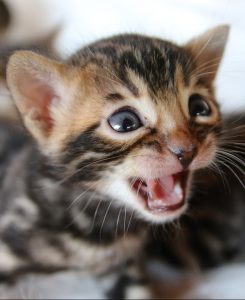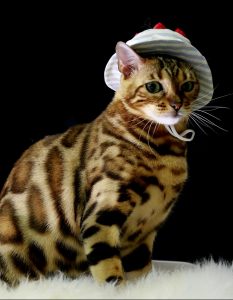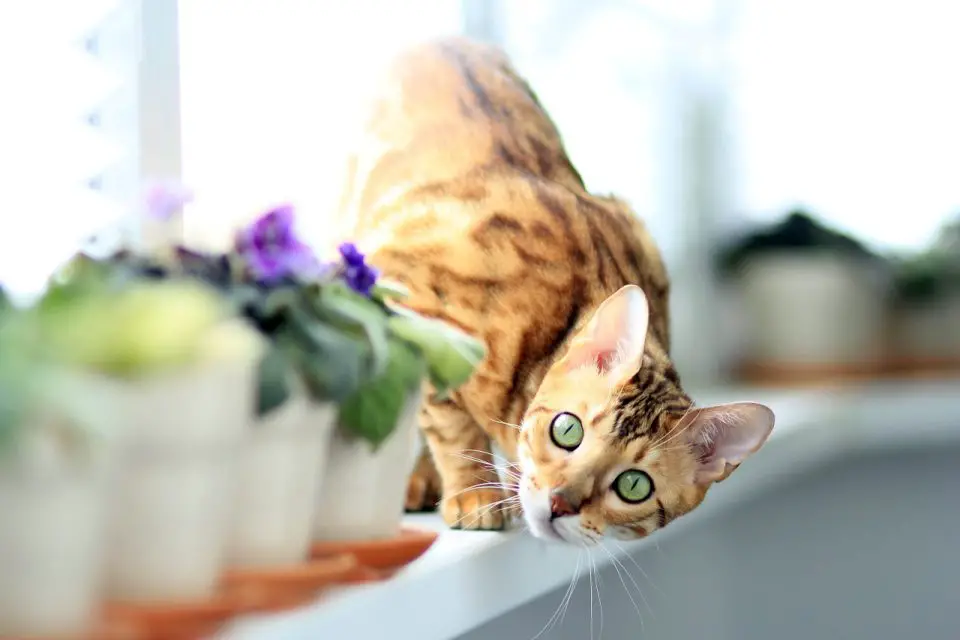Hi, my name’s Irena and I live on the beautiful island of Crete in Greece.
I have a crazy, but lovable dog called Sherlock and three cats, Hammie, Dimitris, and Ebony. Today we’re going to take a look at Bengal cats and whether they are hypoallergenic or not.
What is a Bengal Cat?
Bengals have a very exotic look. They were developed by mating Asian Leopard cats with domestic cats.
They are medium-large cats and weigh between 8 and 15 pounds or even more.
These cats are big-boned, shorthaired, and have spotted or marble coats of many different colors. They look a bit like a miniature leopard.
They can be brown tabbies, seal mink tabbies, black silver tabbies or seal silver lynx points.
Their coats can be a random mixture of spots, a marbled appearance with horizontal stripes on a light background, or they can have horizontal patterns.
Some Bengals can even have a glittery coat. They certainly are striking cats.
Bengals are not cats for couch potatoes. They are intelligent and highly active.
They love climbing, playing fetch, and going for a walk on a leash. Some even enjoy playing in water. My cats, on the other hand, avoid water like the plague!
Bengals are generally healthy cats but there are a few diseases that they can get like hip dysplasia which can cause lameness.
They can also get distal neuropathy which is a disorder of the nervous system, heart disease, and progressive retinal atrophy, a degenerative eye disorder.
It is best to have Bengals as indoor cats even though they are highly active.
There are a lot of people out there who might kidnap your Bengals as they are such unusual and attractive cats. They are also worth a lot of money.
Keeping them indoors also protects them from catching diseases from other cats, prevents them from having fights with other cats or being attacked by dogs and stops them from being hit by a car.
In addition, Bengals are hunters so keeping them indoors stops them from killing birds and other wildlife. If possible, build them an enclosure outside where they can climb and jump safely.
Are Bengal Cats Hypoallergenic?
| Bengal cats are hypoallergenic to a certain degree. However, no cats are completely hypoallergenic. Bengals are just one of the breeds that cause fewer allergies than others. |
Fel d 1 is one of the most common cat allergens. It is found in cat saliva, urine, and skin cells. This is why even hairless cats can cause allergies. Fed d 1 gets into the air via cat hair and dander (dead skin cells).
You will find that people can be more allergic to cats than to dogs. This is because the allergen is so much lighter on cats and stays airborne longer.
Because of this, it is more likely to get into the lungs of people with allergies. Fel d 1 is also sticky so once it gets on the surfaces of your furniture and clothes, it doesn’t go away easily.
Bengals are single coated and as a result, have far less Fel d 1 than longer haired cats.
This means that even if you do have an allergy to this protein, you may be able to have Bengal cats and not suffer any ill effects.
Before you adopt a Bengal visit a home if it’s possible which has Bengal cats. Wait for 24 hours and see if you have allergic reactions.
However, it’s not a good idea to go to a breeder’s home because you will be exposing yourself to a lot of Bengals and as a result a high concentration of the allergens.
You will be more likely to react to the cats there rather than if you visited a house with just one or two Bengals.
Do Bengal Cats Shed a Lot?
Because they are single coated, Bengals don’t shed as much as longer haired cats. Their coats feel a little like soft rabbit fur and are sleek.
This means that Bengals don’t need to groom themselves as much so less saliva spreads onto their coats. This means that less hair and dander are released into the atmosphere.
If you do have allergy sufferers in your family, why not install an air filtration system?
It will remove some of the protein particles floating through the air and will make ownership of Bengal cats a reality for allergy sufferers.
How to Mitigate Allergies Around Bengal Cats
 There are plenty of ways to reduce the number of allergens in the air. One is meticulous grooming.
There are plenty of ways to reduce the number of allergens in the air. One is meticulous grooming.
It has been proved that this helps to stop shedding to a certain degree, especially in kittens up to two years old.
Bengals certainly don’t mind being groomed and it develops a strong bond between cat and human.
Another thing that will help mitigate allergies around Bengal cats is to put them on a raw food diet.
This will improve the quality of their skin and fur and lead to less shedding. 30% of the protein your cats consume is absorbed by the skin which makes it silky and smooth.
If your cats are getting a diet low in protein and have too many empty fillers like wheat, corn, and soy they won’t be getting the right ingredients to maintain peak condition.
A raw food diet will give them enough nutrients their bodies need. A good addition to the meal is Omega 3 fatty acids.
Perhaps add a little tuna fish or salmon into their diets. This will all make their skin supple and healthy which leads to less dander and hair going into the atmosphere.
It has been shown that a lot of allergy sufferers have had their symptoms disappear once they switched their Bengals to a raw food diet.
What if Your Bengal Sheds Excessively?
Bengal cats don’t have a reputation for shedding a lot. Because of this, if your cats suddenly start to shed profusely and end up with bare patches, then you will know that there is something wrong.
A deficiency of nutrients could be the reason. Perhaps your Bengals are on a shop-bought diet.
There’s nothing wrong with that, but make sure that it is a more expensive brand and read the ingredients either on the packet or on-line.
Of course, if you have the time to prepare it, a raw food diet should solve all your problems.
If your Bengals are already on a nutritious diet complete with plenty of protein, vitamins, and some carbohydrates but are still shedding, it might be the time to go and see your vet.
There could be an underlying health condition that has led to excessive hair loss.
Cats That are More Hypoallergenic
Bengals are cats that are hypoallergenic to a certain degree. They are certainly in the top ten of hypoallergenic cats, but what other cats should you consider if you suffer from allergies?
One example is the Cornish Rex which has noticeably short curly fur that lies close to its body. The Devon Rex is remarkably similar.
They have a thin coat of curly fur. Because they have short and fine fur, they don’t shed a lot, although of course there is a little shedding.
The only cats that don’t shed fur are the purebred hairless cats like the Sphynx.
However, they are not completely hairless as they have a fine down on their bodies just like a fuzzy peach.
In addition, they have dander which means that some allergens will be released into the air.
There are more cat breeds that are also hypoallergenic including Oriental Shorthairs and Russian Blues. Both are short-haired and shed minimally.
The Balines produce less Fel d 1 protein in their saliva so they are almost hypoallergenic.
The Siberian cat breed which comes from Russia is long-haired but there are claims that they are hypoallergenic.
Javanese cats only have one of the three layers of coats that regular cats have, just like the Devon and Cornish Rexes.
Both Laperms and Siamese cats don’t shed much. Laperms have curly textured coats that aren’t prone to shedding.
The Burmese with their sand-colored coats, golden color eyes, and short silky coats don’t produce many allergens.
The Colorpoint Shorthair which is a cross between the Siamese and the American Shorthair sheds less than many other cat breeds.
The Ocicat looks a lot like the Bengal, but they are smaller. However, they have the same hypoallergenic properties that Bengals have.
Final Thoughts: Are Bengal Cats Hypoallergenic?
 I think we are safe to say that Bengals are up there in the top ten of cats which produce the fewest allergens.
I think we are safe to say that Bengals are up there in the top ten of cats which produce the fewest allergens.
We can’t say that Bengal Cats are completely hypoallergenic because no cat is, but they produce very little Fel d 1 so you can expect to suffer very few allergic reactions.
Bengals are very handsome cats and are well worth investing in if you have allergies.
If you groom them often and feed them a nutritious diet, you can expect them to shed very little fur, and therefore they won’t cause allergies.
